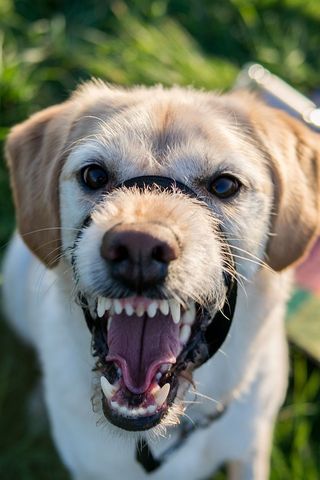Anger
Tools for Managing the Aggressive Dog
Sometimes a simple tool can go a long way toward keeping people safe.
Posted October 18, 2016

By: Liz Stelow, DVM, DACVB, Clinical Animal Behavior Service at the UC Davis William R. Pritchard Veterinary Medical Teaching Hospital.
When a dog has been diagnosed with aggression, whether toward people or other targets, it's important to put a comprehensive treatment plan into place. Such a plan will, eventually, focus on using desensitization and counter-conditioning to help the dog be less reactive to things that trigger its aggressive behaviors. But, in the meantime, the owners will rely on management (sometimes called "Safety and Avoidance") to keep everyone safe. Many tools are available to aid in managing the aggressive dog.
- Opaque Window Film. Many dogs bark out the front windows of the house when delivery people, passersby, and people walking dogs walk by. For dogs that are aggressive toward strangers and other dogs in other settings, this in-home behavior constitutes practice for the overall aggression. Dog owners can use opaque window film to block the visual input of people/dogs going by. This film should be place as high up as the dog can see out (keep in mind how high he gets when standing on furniture. It is applied to the windows with soapy water and is easy to clean off when no longer needed.
- White Noise. Along the same lines, white noise in the home can block the auditory input of people and dogs going by. Dedicated white noise machines or radios can be placed at the front of the house, near the windows. If the dog will remain in the interior of the home, a television can play the same role. Also, if owners will be present a white noise website or app (www.asoftmurmur.com or similar) can also provide a great mix of white noise.
- ThunderCap. While opaque window film is great inside the house, it is not useful when the dog is in the car or on a walk. The ThunderCap provides a similar function: the dog wears it over his eyes and it blocks much of the visual input from the environment. Because wearing it is an experience that most dogs will find very foreign, great care should be taken to acclimate the dog, working at his pace and using treats, before it is ever used on a walk or in the car.
- Head Collar. Gentle Leader, Halti, and other brands of head collars can be useful tools for the owners of dogs who display aggression. The owner will be more relaxed on walks, knowing that he or she has good control over the dog's head – the part that might try to bite. The same caveat noted for the ThunderCap applies here: the dog should be acclimated to wearing it before it is ever used on a walk.
- Crate or Bedroom Door. If the dog is aggressive toward strangers, the owners can put the dog in a crate or behind a bedroom door when people come to visit. We can't expect the fearfully aggressive dog to be on its best behavior when triggered by strangers visiting; so, relieving the dog's stress while ensuring the visitors' safety is a prudent thing to do. The dog should receive a great treat/long lasting food toy so that the separation will not seem like punishment.
- Basket Muzzle. For dogs that bite – or whose owners are fearful that they will – basket muzzles can be a very useful tool. The muzzle allows the owner to be more relaxed on walks, which translates to reduced arousal in the dog, who senses from the owner that all must be well. As with other tools made for the head, a basket muzzle needs to be fitted correctly and the dog must be acclimated to it before using it. Cloth or mesh muzzles are far less desirable (not recommended), as they do not allow the dog to drink or pant but do allow the dog to bite. Another caveat: just because the dog cannot bite while wearing a muzzle, it is not to be used to take the dog to a setting he will find emotionally challenging to be. Additionally, he can "muzzle punch" or injure people in other ways, despite not being able to bite.
There are other tools that can be used for managing a dog's aggression; but these are the most useful.


